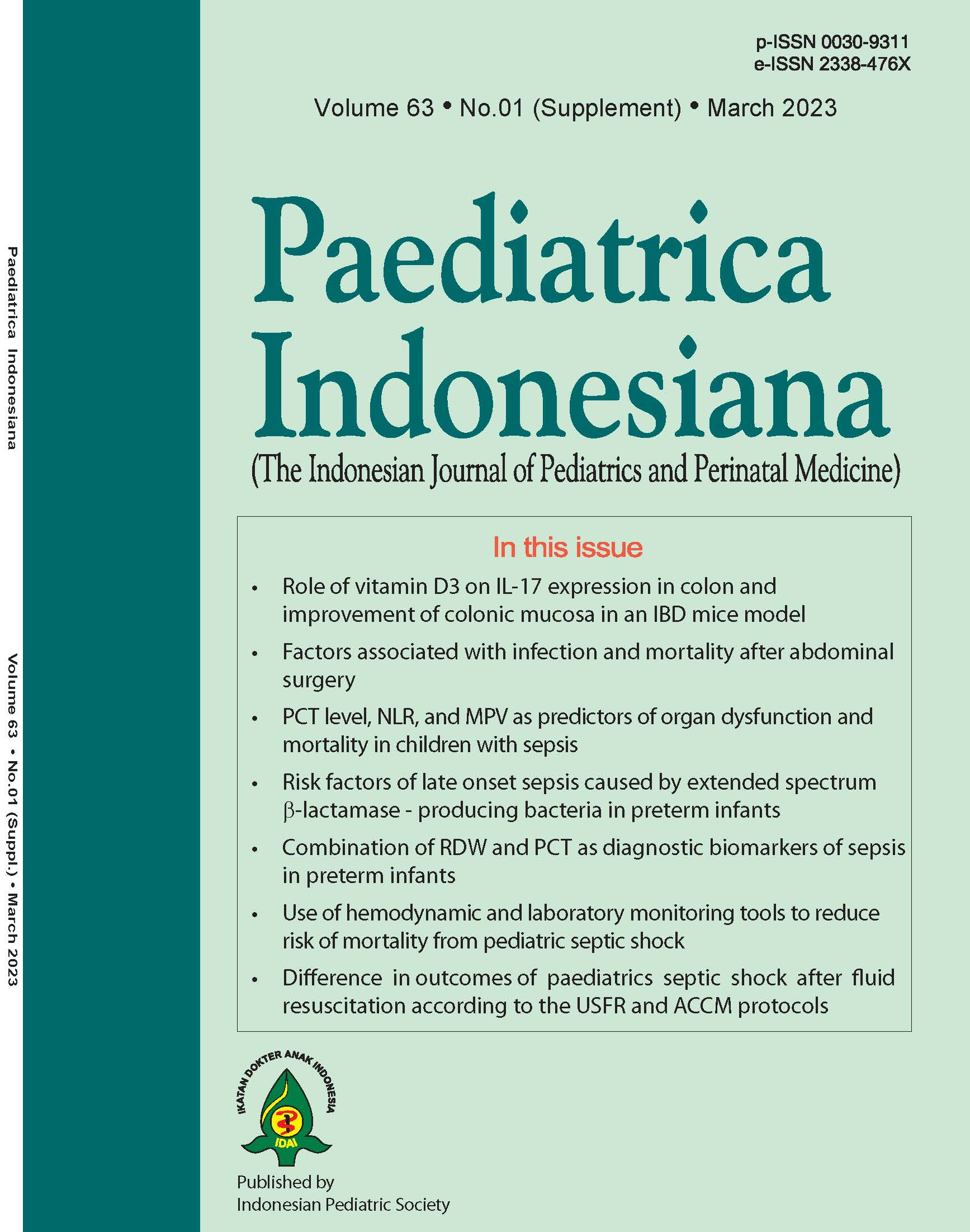Risk factors of late onset sepsis caused by extended spectrum beta-lactamase (ESBL) - producing bacteria in preterm infants
Abstract
Background High incidence of late-onset sepsis (LOS) in preterm infants contributes to neonatal morbidity. Therapeutic outcomes of LOS have deteriorated as a result of increased antibiotic resistance problems, mainly from ESBL isolates. Controlling risk factors is important in reducing morbidity and mortality as well as providing guidance for antibiotic selection.
Objectives To determine the risk factors of LOS due to ESBL-producing bacteria in preterm infants.
Methods This is a retrospective study. The inclusion criteria was neonates diagnosed with late-onset neonatal sepsis by clinical signs and a positive blood culture. The blood culture result and characteristics patients as secondary data were extracted from medical records within the hospital facilities and the institutional database of the Neonatology Department of Universitas Brawijaya (January 2019 to March 2021). Statistical analysis was done to compare characteristics of the patients in the ESBL positive group to those in the ESBL negative group to assess the potential risk factors.
Results Among 124 preterm infants with LOS, 62 of them were ESBL-positive case subjects and the other 62 were non-ESBL-producing control subjects. Gram-negative bacteria were the most common pathogens identified, with 96% (n=59) of them being the ESBL-producing strain, predominated by Klebsiella pneumoniae (n=56). Factors significantly correlated with the occurrence of LOS-ESBL included prior history of invasive procedures (OR 3.13; 95%CI 1.45 to 6.73; P=0.00), central access insertion (OR 9.54; 95%CI 3.7 to 24.2; P=0.00), and parenteral nutrition (OR 6.03; 95%CI 2.77 to 13.16; P=0.00). Central access insertion had the strongest influence (Exp(B) 6.98; P= 0.00).
Conclusion Prior invasive procedures, central access insertion, and parenteral nutrition had significant correlations with the occurrence of LOS-ESBL in preterm infants. Central access insertion is a predictive factor for LOS-ESBL.
References
2. Blencowe H, Vos T, Lee AC, Philips R, Lozano R, Alvarado MR, et al. Estimates of neonatal morbidities and disabilities at regional and global levels for 2010: introduction, methods overview, and relevant findings from the Global Burden of Disease study. Pediatr Res. 2013;74:4-16. DOI: https://doi.org/10.1038/pr.2013.203.
3. Ganatra HA, Zaidi AK. Neonatal infections in the developing world. Semin Perinatol. 2010;34:416-25. DOI: https://doi.org/10.1053/j.semperi.2010.09.004.
4. Gomella TL, Cunningham MD, Eyal FG, Zenk KE. Neonatology: management, procedures, on call problems, diseases, and drugs. 8th ed. New York: Lange Medical Books/McGraw Hill Medical Publishing; 2020. p. 1175-85.
5. Logan LK, Meltzer LA, McAuley JB, Hayden MK, Beck T, Braykov NP, et al. Extended-spectrum B-lactamase-producing enterobacteriaceae infections in children: a two-center case-case-control study of risk factors and outcomes in Chicago, Illinois. J Pediatric Infect Dis Soc. 2014;3:312–9. DOI: https://doi.org/10.1093/jpids/piu011.
6. Zaidi AK, Tikmani SS, Warraich HJ. Community-based treatment of serious bacterial infections in newborns and young infants: a randomized controlled trial assessing three antibiotic regimens. Pediatr Infect Dis J. 2012;31:667–72. DOI: https://doi.org/10.1097/INF.0b013e318256f86c.
7. Li X, Xu X, Yang X, Luo M, Liu P, Su, et al. Risk factors for infection and/or colonization with extended-spectrum ?-lactamase-producing bacteria in the neonatal intensive care unit: a meta-analysis. Int J Antimicrob Agents. 2017;50:622–628. DOI: https://doi.org/10.1016/j.ijantimicag.2017.06.027.
8. Vijayakanthi N, Bahl D, Kaur N, Maria A and Dubey, NK. Frequency and Characteristics of Infections Caused by Extended-spectrum Beta-Lactamase-Producing Organisms in Neonates: a Prospective Cohort study. Biomed Res Int.. 2013;7:6. DOI: https://doi.org/10.1155/2013/756209.
9. Wang ME, Patel AB, Hansen NI, Arlington L, Prakash A and Hibberd PL. Risk factors for possible serious bacterial infection in a rural cohort of young infants in central India. BMC Public Health. 2016;1:1097. DOI: https://doi.org/10.1186/s12889-016-3688-3.
10. Sharma D, Kumar C, Pandita A, Pratap OT, Dasi T and Murki S. Bacteriological profile and clinical predictors of ESBL neonatal sepsis. J Matern Fetal Neonatal Med. 2016;29:567-570. DOI: https://doi.org/10.3109/14767058.2015.1011118.
11. Afonso EDP and Blot S. Effect of gestational age on the epidemiology of late-onset sepsis in neonatal intensive care units - a review. Expert Rev Anti Infect Ther. 2017;15:917–924. DOI: https://doi.org/10.1080/14787210.2017.1379394.
12. Dong Y, Glaser K, & Speer CP. Late-onset sepsis caused by Gram-negative bacteria in very low birth weight infants: a systematic review. Expert Rev Anti Infect Ther. 2019; 17:177-188. DOI: https://doi.org/10.1080/14787210.2019.1568871.
13. Huang FK, Chen HL, Yang PH and Lin HC. Bird's Eye View of A Neonatologist: Clinical Approach to Emergency Neonatal Infection. Pediatr Neonatol. 2007;57:167-173. DOI: https://doi.org/10.1016/j.pedneo.2015.06.004.
14. Litz JE, Goedicke-Fritz S, Härtel C, Zemlin M, & Simon A. Management of early- and late-onset sepsis: results from a survey in 80 German NICUs. Infection 2019;47:557-564. DOI: https://doi.org/10.1007/s15010-018-1263-9.
15. Kamath S, Mallaya S and Shenoy S. Nosocomial Infections in Neonatal Intensive Care Units: Profile, Risk Factor Assessment and Antibiogram. Indian J Pediatr. 2010;77:37-9. DOI: https://doi.org/10.1007/s12098-010-0005-5.
16. Harris AD, McGregor JC, Johnson JA, Strauss SM, Moore AC, Standiford HC, et al. Risk factors for colonization with extendedspectrum ?-lactamase–producing bacteria and intensive care unit admission. Emerg Infect Dis. 2007;13:1144-9. DOI: https://doi.org/10.3201/eid1308.070071.
17. Szél B, Reiger Z, Urbán E, Lázár A, Mader K, Damjanova I, et al. Successful elimination of extended-spectrum beta-lactamase (ESBL)-producing nosocomial bacteria at a neonatal intensive care unit. World J Pediatr. 2017;13:210-216. DOI: https://doi.org/10.1007/s12519-016-0069-z.
18. Dramowski A, Aucamp M, Beales E, Bekker A, Cotton MF, Fitzgerald FC, et al. Healthcare-associated infection prevention interventions for neonates in resource-limited settings. Front.Pediatr. 2022;10:1-12. DOI: https://doi.org/10.3389/fped.2022.919403.
Copyright (c) 2023 Irene Ratridewi, Savitri Laksmi Winaputri, Eko Sulistijono, Fireka Imsa Sastia Juniantika

This work is licensed under a Creative Commons Attribution-NonCommercial-ShareAlike 4.0 International License.
Authors who publish with this journal agree to the following terms:
Authors retain copyright and grant the journal right of first publication with the work simultaneously licensed under a Creative Commons Attribution License that allows others to share the work with an acknowledgement of the work's authorship and initial publication in this journal.
Authors are able to enter into separate, additional contractual arrangements for the non-exclusive distribution of the journal's published version of the work (e.g., post it to an institutional repository or publish it in a book), with an acknowledgement of its initial publication in this journal.
Accepted 2023-03-16
Published 2023-03-16













